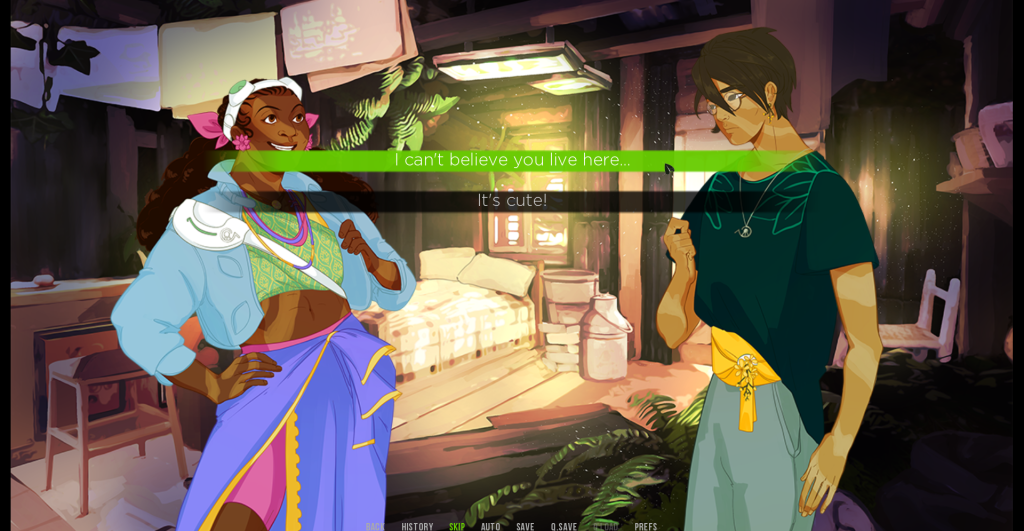Play
 An image from "Dark City." Art by Sara "Dari" Eskandari. Text and code by Gregory Keng Strasser
An image from "Dark City." Art by Sara "Dari" Eskandari. Text and code by Gregory Keng Strasser
A New Method of Delivery: Pivoting with “Dark City”
September 1, 2022 @ 12:00pm
A city built around a tree, its residents desperate to climb up: That’s the image that Gregory Keng Strasser says kickstarted his project “Dark City.”
“It’s always about trying to get to the top,” Strasser says. “Inevitably, as you’re trying to rise to the top, you’re going to knock people out of your way, and they’re going to fall, right? And there’s no way to cushion a fall from verticality.”
The fantastical world of “Dark City” tackles capitalism, corruption and crime, in a story developed by Strasser, artistic lead Sara “Dari” Eskandari and their team in concert with 4615 Theatre Company. The characters have complex backstories, the plot is full of ups and downs, the dialogue is realistic. But “Dark City” isn’t a play.
It’s a video game.
Released last year, “Dark City” represents a pandemic-forced pivot for 4615, a Bethesda company. As theaters wrestled with how best to show off their work, D.C. theatre director Seema Sueko helped Strasser change his mentality.
“‘Audiences, they still exist. They’re hurting, but they still exist. Artists, they still exist,’” Strasser says Sueko told him. “‘What has been damaged beyond repair is the method of delivery by which the theater artists get their art to the audiences.’”
When Strasser pitched his friend Eskandari on the project, that’s the exact line he used. Preserve the art, the personality, the drama — but make it accessible.
“If you like reading scripts, this is just an illustrated and interactive script,” Eskandari says.
And if you like excitement? Well, “Dark City” has action aplenty: Juda’s sister Paaya is murdered, investigative journalist Liki starts digging around and the squeaky-clean environmentalist facade of Aeolus, the city-in-a-tree, begins looking more and more murky.
The game is a visual novel, a form of interactive digital storytelling. Players alternate between being Juda or Liki in each of the four chapters, with three different ways of affecting the storyline: extracting information from other characters, searching for clues in the environment and making decisions in a quest to keep allies and build a case.
Strasser offers a quick example: Clicking around at a mysterious power plant helps gather evidence. Later in the game, the player can use it to confront a police officer.
“By using some of the evidence you’ve gathered in that environment, it makes the job a lot easier for you,” he says.
As for what the environment looks like: Aeolus City’s design draws from Bangkok, Taipei and Shanghai. The written language pulls on the scripts of Thai and Telugu. The characters’ get-ups are inspired by Thailand Fashion Week.
Research may be par for the course in theatre, but the player’s power and divergent endings represent a shift — for fans, and for creators. Strasser learned to program for “Dark City,” getting inspiration from other games and advice from online channels. Eskandari, who had previous experience with games, helped him find parallels.
“I actually had a dictionary that I gave you and Aria [Velz, who contributed work,] of translating video game terms to theatre terms,” Eskandari reminisces with Strasser.
“Assets were props, backgrounds were scenic design,” Strasser chimes in.
Vocab swap aside, Eskandari’s outfit designs measure up to that of any costume designer. Juda’s leafy green shirt, the delicate yellow flowers around his waist, Liki’s fuschia floral earrings: Eskandari wove the solarpunk environmentalist aesthetic of Aeolus City into every detail.
The worldbuilding is equally deliberate. The Vassari ethnic group dominates Aeolus City, oppressing the other residents, the Edda. Thicker patterns swirling on their faces distinguish the Edda from the Vassari’s thinner-lined character design.
Other than that, the two groups are phenotypically identical — a deliberate choice, and a rejection of most fantasy norms.
“We really, really, really, really, really wanted to avoid what many fantasy genres tend to do, in which they have different ethnicities within a race have inherent magical powers between one ethnicity or another,” Eskandari says.
That’s because “Dark City” isn’t about inherent genetic differences. Magical distinctions between the Edda and Vassari are all cultural, concerned with questions of identity and heritage.
Through side character Gideon, a mixed Vassari and Edda character, the creators talk about passing and internalized racism. With Liki, Paaya and Juda — all Edda — they push back against the token one-character-of-each-race that’s so typical in fantasy. And by making Juda an immigrant to Aeolus City, though many Edda are Indigenous to the area, they ask questions about belonging and assimilation.
“I think that hearkens back to an identity that Sara and I both share as biracial people,” Strasser points out. “Because I’m Chinese and white. I have always felt a little bit of out-of-placeness.”
But among the “Dark City” team, he found community, making a game Eskandari describes as “by biracial people” and “ultimately intended for them.”
Eskandari says they could tell everyone on the notably diverse team cared about telling a strong story, and a respectful one. They’re blunt about the lesson they learned from that experience, the lesson they want the “Dark City” audience to take away:
“Diversify your f—ing teams.”
Visit 4615theatreco.itch.io to purchase, download and play “Dark City.” The first episode is available for free.
Gregory Keng Strasser: gregorykengstrasser.com // @lil.scallion.pancake
Sara “Dari” Eskandari: seskanda.artstation.com // @_seskanda
Enjoy this piece? Consider becoming a member for access to our premium digital content. Support local journalism and start your membership today.







